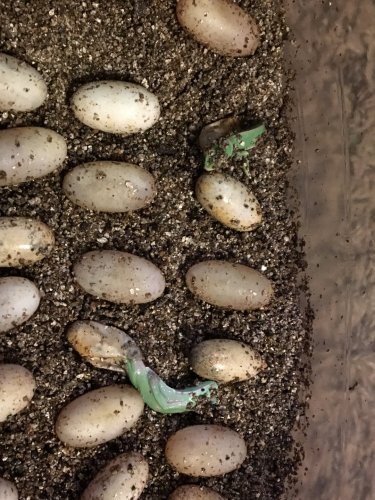jajeanpierre
Chameleon Enthusiast
Some more pics still just 4 so far
Cute babies, but all the pictures have their eyes closed, even the picture of one on your hand. Something is wrong. Or did you take the pictures at night when they were sleeping?
I see a red light on one picture. Are you adding heat to them? They likely don't need any heat added. Babies need to be cooler than adults.
How are you hydrating them? I see you have a screen cage with a dripper. I've never had baby veileds, but I would suspect they will dehydrate in the conditions you have. Your cage is on top of a wooden table, no drainage pan and the table is on carpet. I can't believe you will put in enough water/mist without flooding the carpet, which means you will probably short change them to avoid damage.
Also, I see you have your eggs open to the air. They also will dehydrate which will make it impossible or difficult for them to hatch.
I see three or four things that I think might be wrong. A single issue could kill them all and you might have more than a single issue. You already should know you have a problem based on the the closed eyes (unless the closed eyes can be explained away by the photo being taken when they were sleeping).
1. Heat. They likely do not need supplemental heat, which will only exacerbate their dehydration
2. Screen cage. I think babies do a lot better in something that has solid sides. You are able to keep the humidity higher for longer.
3. Humidity/Hydraton. I don't know that hand misting or a dripper will be adequate for babies, and if it is you will be having water pool in the cage and onto the floor. Don't expect babies to be able to figure out how to find water from a dripper. It looks like you have artificial plants in the baby cage, which don't hold water droplets for very long. A live plants gives off humidity as it breathes, so the air around the plant will always be more humid which means the water droplets from the mist won't evaporate as quickly.
4. Eggs. The box should be closed up and in a cooler place than the babies.
Good luck with them. Although veileds are incredibly tough, neonates are not. Babies are fragile and it is often too late by the time a breeder realizes things aren't right. You don't have a lot of time to get it right before you end up with a disaster.
Good luck with them. I hope I am over reacting and all turns out well for them.





